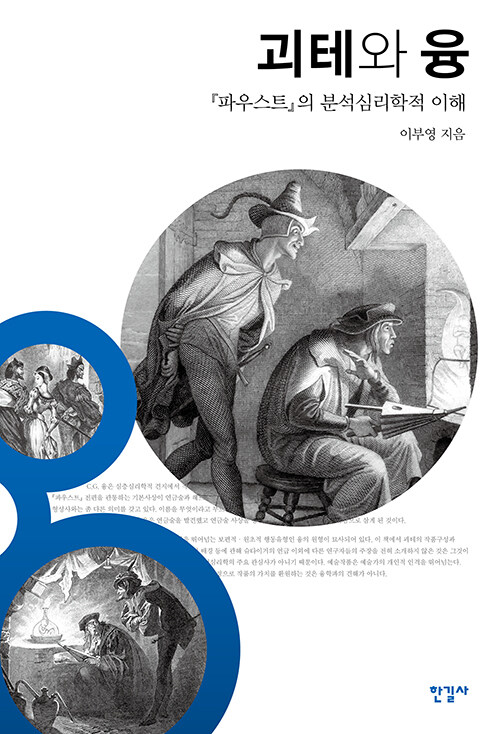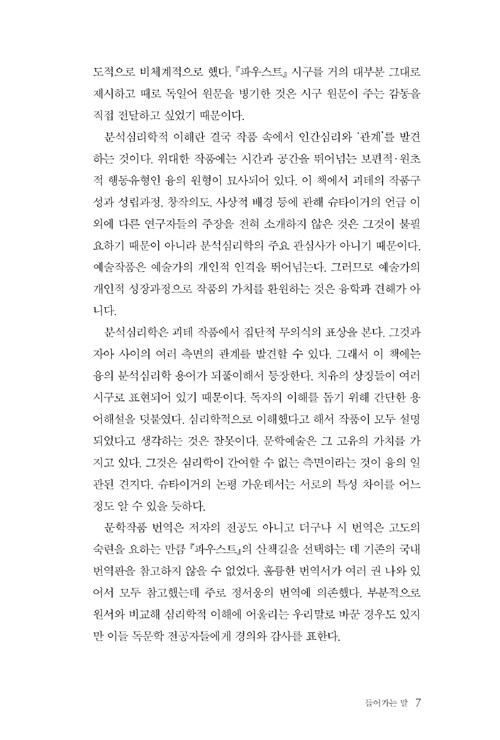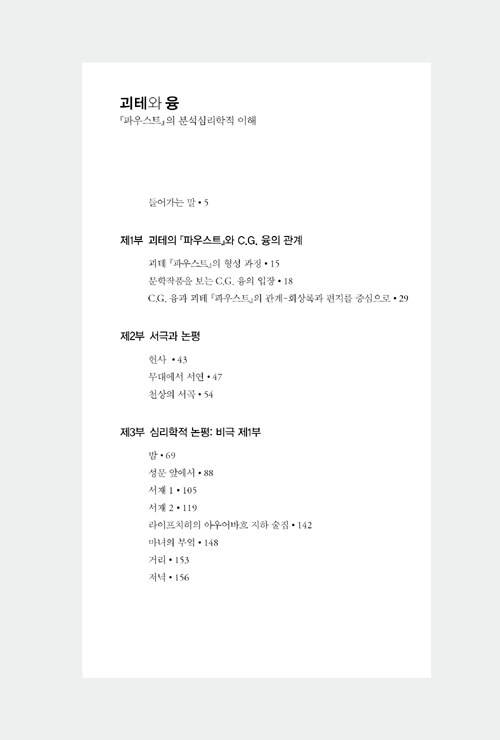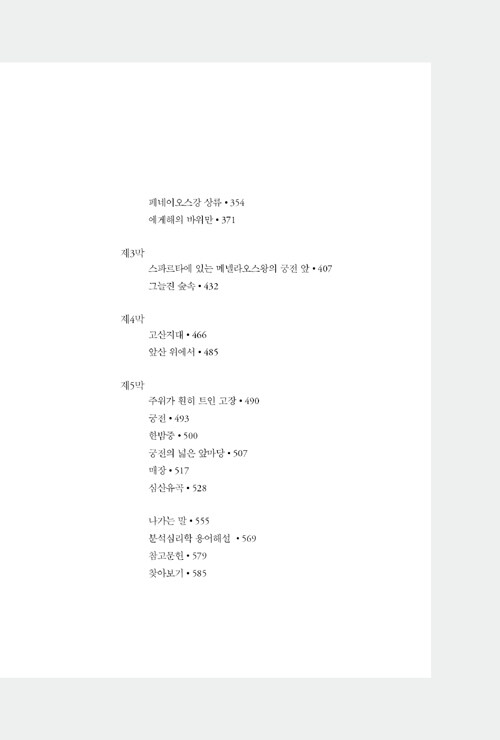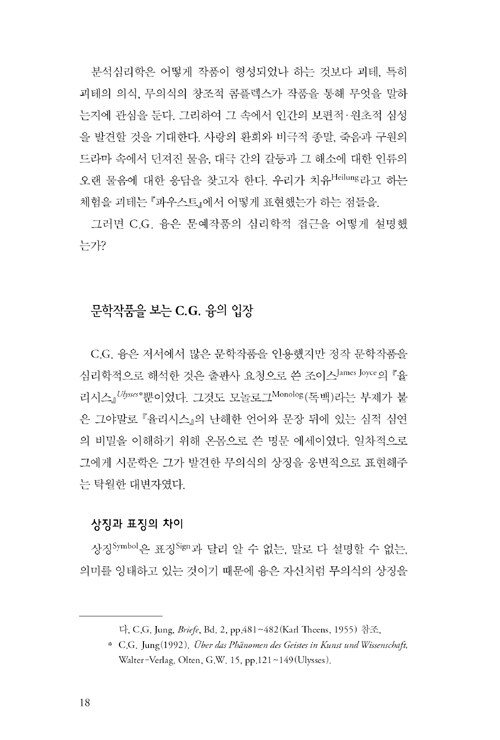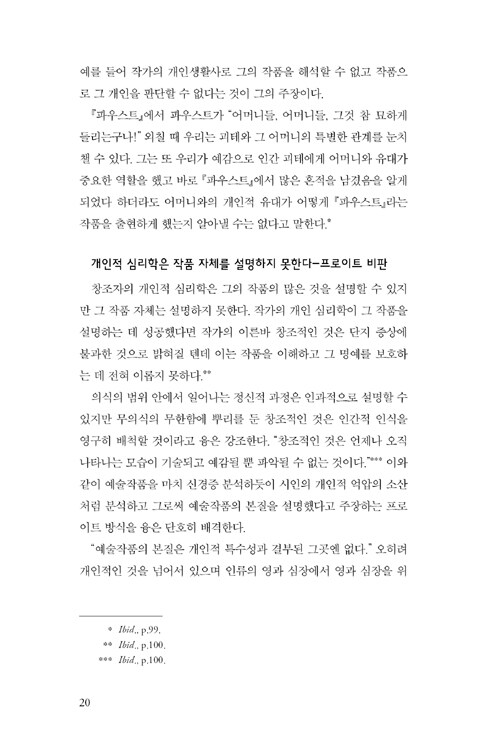 |
- 정가35,000원
- 판매가31,500원 (10%, 3,500원 할인)
기본정보
이벤트
책소개
한국 분석심리학의 대가 이부영이 괴테의 『파우스트』를 융의 분석심리학적 견지에서 해석한 결과물이다. 이 작업은 인류의 집단무의식을 발견하고 인간의 자기실현에 대한 해답을 얻고자 하는 데 목적이 있다.
불후의 고전 『파우스트』는 방대하고 풍부한 상징과 수수께끼로 가득 차 있다. 그러나 동시에 위대한 작품에는 시간과 공간을 뛰어넘는 인간의 보편적·원초적 행동유형과 심상이 담겨 있다. 저자 이부영은 『파우스트』를 현대인의 마음에 살아 있는 심혼의 상들, 인간 무의식의 원초적·집단적 표상, 융의 원형적 상징들과의 관계 파악 등 분석심리학적 방식으로 꼼꼼하게 분석했다.
또한 극의 전 과정을 따라가면서 극 중 인물들과 공감하고 간접 체험함으로써 괴테의 의식과 무의식의 창조적 콤플렉스가 작품을 통해 무엇을 말하는지에 대해 탐구한다. 그 속에서 사랑의 환희와 비극적 종말, 죽음과 구원의 드라마 속에 던져진 물음, 대극 간의 갈등과 그 해소에 대한 인류의 오랜 물음에 대한 답을 찾고자 한다.
불후의 고전 『파우스트』는 방대하고 풍부한 상징과 수수께끼로 가득 차 있다. 그러나 동시에 위대한 작품에는 시간과 공간을 뛰어넘는 인간의 보편적·원초적 행동유형과 심상이 담겨 있다. 저자 이부영은 『파우스트』를 현대인의 마음에 살아 있는 심혼의 상들, 인간 무의식의 원초적·집단적 표상, 융의 원형적 상징들과의 관계 파악 등 분석심리학적 방식으로 꼼꼼하게 분석했다.
또한 극의 전 과정을 따라가면서 극 중 인물들과 공감하고 간접 체험함으로써 괴테의 의식과 무의식의 창조적 콤플렉스가 작품을 통해 무엇을 말하는지에 대해 탐구한다. 그 속에서 사랑의 환희와 비극적 종말, 죽음과 구원의 드라마 속에 던져진 물음, 대극 간의 갈등과 그 해소에 대한 인류의 오랜 물음에 대한 답을 찾고자 한다.
목차
책속에서
첫문장 | 괴테의 『파우스트』는 C.G. 융이 자신의 저서에서 제일 많이 인용한 문학작품이다. |
- P. 22 심리학적 견지에서 보면 『파우스트』야말로 문학작품의 두 극단적인 특징을 보인다고 융은 말한다. 앞부분은 창작의 심리적 양식, 뒤의 것은 환상적(幻像的, visionare) 양식이라 이름할 수 있다고 했다. 심리학적 양식은 소재의 내용이 인간의식이 미치는 범위 안에서 움직인다. 즉, 인생 경험, 충격적이거나 열정적인 인간 체험, 일... 더보기

- P. 64 인간은 살아 있는 한 그림자를 가진다. 왜냐하면 의식은 항상 일방적으로 활동하므로 이에 어긋나는 측면은 무의식에 억압되고 그림자를 형성하게 마련이기 때문이다. 무의식의 그림자로 말미암아 생기는 긴장과 갈등은 위의 말대로 인간을 ‘자극하고 일깨우는’, 그래서 그림자를 의식화하도록 촉구하는 무의식의 의도를 나타내는 것이다. 위 시구는... 더보기

- P. 115 메피스토의 말을 심리학적 언어로 번역한다면 인간(자아)은 자신이 지각하고 생각하고 느끼는 의식된 자신을 전부라고 생각한다. 의식의 빛이 무의식의 어둠에서 나온 것을 잊은 채 의식으로 모든 것을 해결하려는 오만에 빠져 있다. 최초에 무의식이 있었고 무의식에서 의식이 태어났다. 의식의 원천, 무의식은 의식보다 넓고 깊다. 아무리 자아... 더보기

- P. 112 어떤 엄청나게 큰 힘에 의해 자아가 아무것도 할 수 없는 상태에 빠진 경우 혹은 할 수 없다고 느끼는 경우, 우리는 여기서 우울의 임상을 발견한다. 파우스트도 그것을 느낀다. 그러나 ‘그의 가슴속에 있는 신’은 최소한 내면 깊이에서는 활발히 움직인다. 행동으로 옮기기가 어려울 뿐이다. 그는 최소한 거친 꿈을 꾼다. 물론 의식이 절... 더보기

- P. 164~165 사랑의 문제에는 항상 아니마가 개입한다. 아니마란 남성 속의 여성성, 개인적 무의식의 콤플렉스이면서 동시에 원형층에 뿌리박고 있는 여성상으로 황홀하거나 추악한 모든 감정을 불러일으키는 존재다. 마찬가지로 여성에게는 아니무스라는 것이 있다. 여성 속의 남성성. 똑같이 집단적 무의식의 원형상이면서 동시에 개인적 무의식의 콤플렉스로 현... 더보기

추천글
- 한겨레 신문- 한겨레 신문 2020년 7월 10일자

- 경향신문- 경향신문 2020년 7월 20일자

이 책을 추천한 다른 분들 :
저자 및 역자소개
이부영 (지은이)
이부영(지은이)의 말
“분석심리학적 이해란 결국 작품 속에서 인간심리와 ‘관계’를 발견하는 것이다.위대한 작품에는 시간과 공간을 뛰어넘는 보편적·원초적 행동유형인 융의 원형이
묘사되어 있다. 분석심리학은 괴테 작품에서 집단적 무의식의 표상을 본다.”
-이부영
출판사 소개
- 최근작 : <한국 땅에서 예술하기 : 임옥상 보는 법>,<두 번째 장소>,<진실과 정의에 대한 성찰>등 총 757종
- 대표분야 : 역사 3위 (브랜드 지수 825,073점), 미술 이야기 19위 (브랜드 지수 20,454점), 철학 일반 19위 (브랜드 지수 25,769점)

출판사 제공 책소개
노자와 괴테를 사랑한 융
인간의 정신은 ‘대극’으로 이루어져 있다. 사랑과 미움, 아름다움과 추함, 선과 악, 남성과 여성, 내향과 외향, 정신과 물질, 빛과 어둠 등 수많은 대극은 인간의 삶에서 자주 긴장과 갈등을 초래한다. 융은 대극이 원만하게 융합되고, 의식과 무의식이 균형을 이루어 개인의 독특한 잠재력을 실현한 상태를 ‘개성화’(individuation), 즉 ‘자기실현’이라고 정의했다. 자기실현은 곧 삶의 목적이기도 하다.
융은 의식의 차원과 관련된 ‘자아’(Ego)와 의식과 무의식을 통틀은 전체정신인 ‘자기’(Selbst, Self)를 구분했다. 동양사상을 누구보다 깊이 이해했던 융은 ‘자기’의 상징을 이야기할 때 언제나 동양의 유례로서 노자의 ‘도’(道)를 제시했다. 저자는 이와 같은 사실을 바탕으로, 2012년 노자의 『도덕경』을 분석심리학적으로 해석한 『노자와 융』을 출간했다.
이후 저자는 서양고전을 분석심리학의 대상으로 삼고 싶다는 소망을 실현하기 위해 노력해왔다. 그 대상이 바로 괴테의 『파우스트』다. 『파우스트』는 융이 자신의 저서에서 가장 많이 언급하고 인용한 작품이기도 하다.
“『파우스트』에 관해서는 내가 보기에 아무리 명상해도 부족하다고 하겠습니다. 왜냐하면 제2부에서 퍼 올리지 못한 비밀이 아직 많기 때문입니다. 내게 가장 중요한 모든 것은 괴테의 『파우스트』에 들어 있습니다.”_융
융은 『파우스트』의 제1부는 개인적인 심리학으로 충분히 이해가 가능한 작품인 데 반해 제2부는 일반 심리학으로는 전혀 이해할 수 없는 숱한 원형적 상징으로 채워진 작품이라고 말했다. 그만큼 『파우스트』에는 신화·민담·설화·종교에서 다루어지는 무수한 집단무의식과 치유의 상징들이 여러 시구로 표현되어 있다. 저자 이부영은 독자들이 『파우스트』를 읽으며 무심히 지나치는 작은 사물과 배경, 등장인물 등 어느 하나도 놓치지 않고 꼼꼼히 분석하며 그 해석은 동서양의 관점을 종횡무진 넘나든다.
왜 『파우스트』인가: 집단무의식의 발견
융은 인간 정신생활의 근본은 무의식이라고 보았다. 무의식에는 개인적 무의식과 집단적 무의식이 있다. 개인적 무의식을 중시한 프로이트와 달리 융은 집단적 무의식에 중점을 둔다. 집단적 무의식은 태어날 때 이미 갖추어진, 인간행동의 보편적이고 원초적인 조건들이 담긴 무의식의 층이다. 의식의 뿌리이자 토대로 많은 신화적 상징을 산출하여 의식의 창조적 변화에 이바지한다.
융은 예술작품을 개인적 억압의 소산처럼 분석하고 그로써 예술작품의 본질을 설명했다고 주장하는 프로이트의 방식을 배격했다. 융은 “예술가는 개인적 충동에 따르는 것이 아니라 집단적 조류에 따른다. 이 조류의 원천은 직접적으로 의식 속에 있는 것이 아니라 근대인이 지닌 정신의 원천인 집단적 무의식에 있다”고 말했다. 그러면서 “예술은 시대정신에 가장 부족한 형상을 드러내기 위해 무의식에 침잠하고 그것을 들어 올려 의식 가까이 갖다놓으면 그것은 형상을 변화시킨다”고 했다. 따라서 예술은 “국가와 시대의 삶에서 하나의 정신적인 자가조절 과정”인 것이며, 개인에게는 자기실현의 과정인 것인다.
왜 『파우스트』인가: 연금술을 통한 대극합일
융과 괴테의 관계는 특별하다. 융의 고백에 따르면 그의 조부는 괴테의 사생아였다는 소문이 있었지만, 그보다 중요한 것은 젊은 시절 개신교 목사의 아들로서 선한 신(神)에 대한 회의와 신의 본체에 대해 끊임없이 고민하던 융에게 괴테는 악의 문제를 진지하게 고민한 도반(道伴)이었다. 기독교 신에 대한 절대적 믿음과 마귀의 위력을 하찮은 것으로 경시하던 1890년대, 청년 융은 신의 어두운 그림자를 직감한 자신에 대한 죄책감에 시달리며 그 해답을 신학서나 철학서에서 찾으려 노력했다.
무의식의 본질을 탐구하며 자기 안의 또 다른 인격의 목소리를 듣게 된 융에게 의식과 무의식의 조화, 대극합일은 자신을 치유하는 과정이기도 했다. 이후 융은 상징적 이해를 통해 『파우스트』를 관통하는 기본사상이 연금술과 헤르메스철학임을 발견했다. 또한 『파우스트』 안에서 인간정신의 대극성과 그 합일과정에 대한 모색을 찾았다.
융은 연금술 문헌에 나오는 수많은 상징적 표현과 정신병 환자의 꿈속에 나타나는 상징적 이미지 간의 연관성을 발견하고 연금술을 집단무의식의 표현으로 여겼다. 또한 연금술사들이 궁극의 목표물이라 여긴 최고의 물질 메르쿠리우스(Mercurius)는 인간정신의 변화과정을 거쳐 이루어진 ‘전체정신’을 상징한다는 사실을 발견하고 이를 ‘자기’라는 말로 표현했다. 메르쿠리우스를 만들기 위해 노력하는 연금술의 과정은 분석심리학에서 대극합일을 통한 자기실현의 과정과 같다고 보았다.
융은 괴테가 연금술을 접했고, 대표적 연금술서인 『화학적 결혼: 크리스티아니 로젠크로이츠』는 『파우스트』를 집필하는 데 상당한 영향을 미쳤을 것으로 보았다. 저자 역시 이에 동의하고 『파우스트』 안의 곳곳에서 그 흔적을 찾았다.
메피스토는 단순히 악마에 불과한가
『파우스트』는 괴테가 26세에 초고를 발표하고 82세에 완성한 작품으로 반세기가 넘는 그의 삶과 정신, 시대경험이 결집된 작품이다. 점성술사 파우스트가 마귀에게 영혼을 팔아 초능력을 발휘하다가 타락해서 지옥에 빠진다는 이야기는 괴테 이전에도 여러 사람이 소설화했다. 그러나 괴테는 이 진부한 소재를 취하여 새로운 인간상을 제시했다. 지식의 한계에서 절망에 빠졌다가도 끊임없이 일어나 삶에 도전하며, 실수와 상처투성이인 지옥행을 겪으면서도 다시 영원한 아름다움을 찾아 나서고, 지상 세계의 번영을 위해 행동하는 인물로 파우스트를 재탄생시켰다.
그동안 메피스토는 악의 대명사로 알려져 있었다. 그러나 융은 오히려 파우스트를 허풍쟁이, 사기꾼 등으로 폄하하며 상대적으로 메피스토를 높이 평가했다. 메피스토를 기독교의 마귀와는 다른 좀더 깊은 뜻을 전하는 존재로 본 것이다. 메피스토는 파우스트의 또 다른 인격이자 무의식의 열등한 인격인 ‘그림자’이지만 한편으로 파우스트를 자연의 신비로 안내하는 자로서 절망에 빠진 그를 자살 직전에 구해 지금까지의 삶을 넘어 깊은 곳으로 인도하는 것은 물론, 어머니들과 ‘신성’(神性)의 신비로 이끈다는 점에서 연금술의 메르쿠리우스에 가까운 존재라고 보았다. 그것은 그림자를 ‘의식화’함으로써 그림자의 부정적 측면이 긍정적·창조적 기능으로 변화하는 개성화의 과정이기 때문이다.
주님: 어디 너의 길로 유혹하여 이끌어보려무나. 하지만 언젠가 부끄러운 얼굴로 나타나 이렇게 고백하게 되리라. 착한 인간은 비록 어두운 충동 속에서도 무엇이 올바른 길인지 잘 알고 있더군요라고._64쪽.
파우스트는 많은 죄를 지었지만 신은 그의 노력과 방황을 함께 감싸 안았다. 융은 이런 『파우스트』의 결말을 매우 안타깝게 여겼다. 파우스트가 승천함으로써 또 다른 자아인 메피스토와 합일을 이루지는 못했기 때문이다.
그러나 저자 이부영은 “삶은 자기실현의 과정이다. 노력하는 인간은 방황하기 마련이고, 방황은 뜻이 있는 고통”이라고 말한다. 파우스트적 충동과 욕망, 눈에 보이는 성취에 집착할 것이 아니라 내면의 마음을 인식하고자 하는 태도가 중요하다는 것이다. 자기 안에 있는 무의식을 마주할 용기가 있다면 어느 날 갑자기 나타난 메피스토와의 만남도 두렵지 않을 것이다. 접기
인간의 정신은 ‘대극’으로 이루어져 있다. 사랑과 미움, 아름다움과 추함, 선과 악, 남성과 여성, 내향과 외향, 정신과 물질, 빛과 어둠 등 수많은 대극은 인간의 삶에서 자주 긴장과 갈등을 초래한다. 융은 대극이 원만하게 융합되고, 의식과 무의식이 균형을 이루어 개인의 독특한 잠재력을 실현한 상태를 ‘개성화’(individuation), 즉 ‘자기실현’이라고 정의했다. 자기실현은 곧 삶의 목적이기도 하다.
융은 의식의 차원과 관련된 ‘자아’(Ego)와 의식과 무의식을 통틀은 전체정신인 ‘자기’(Selbst, Self)를 구분했다. 동양사상을 누구보다 깊이 이해했던 융은 ‘자기’의 상징을 이야기할 때 언제나 동양의 유례로서 노자의 ‘도’(道)를 제시했다. 저자는 이와 같은 사실을 바탕으로, 2012년 노자의 『도덕경』을 분석심리학적으로 해석한 『노자와 융』을 출간했다.
이후 저자는 서양고전을 분석심리학의 대상으로 삼고 싶다는 소망을 실현하기 위해 노력해왔다. 그 대상이 바로 괴테의 『파우스트』다. 『파우스트』는 융이 자신의 저서에서 가장 많이 언급하고 인용한 작품이기도 하다.
“『파우스트』에 관해서는 내가 보기에 아무리 명상해도 부족하다고 하겠습니다. 왜냐하면 제2부에서 퍼 올리지 못한 비밀이 아직 많기 때문입니다. 내게 가장 중요한 모든 것은 괴테의 『파우스트』에 들어 있습니다.”_융
융은 『파우스트』의 제1부는 개인적인 심리학으로 충분히 이해가 가능한 작품인 데 반해 제2부는 일반 심리학으로는 전혀 이해할 수 없는 숱한 원형적 상징으로 채워진 작품이라고 말했다. 그만큼 『파우스트』에는 신화·민담·설화·종교에서 다루어지는 무수한 집단무의식과 치유의 상징들이 여러 시구로 표현되어 있다. 저자 이부영은 독자들이 『파우스트』를 읽으며 무심히 지나치는 작은 사물과 배경, 등장인물 등 어느 하나도 놓치지 않고 꼼꼼히 분석하며 그 해석은 동서양의 관점을 종횡무진 넘나든다.
왜 『파우스트』인가: 집단무의식의 발견
융은 인간 정신생활의 근본은 무의식이라고 보았다. 무의식에는 개인적 무의식과 집단적 무의식이 있다. 개인적 무의식을 중시한 프로이트와 달리 융은 집단적 무의식에 중점을 둔다. 집단적 무의식은 태어날 때 이미 갖추어진, 인간행동의 보편적이고 원초적인 조건들이 담긴 무의식의 층이다. 의식의 뿌리이자 토대로 많은 신화적 상징을 산출하여 의식의 창조적 변화에 이바지한다.
융은 예술작품을 개인적 억압의 소산처럼 분석하고 그로써 예술작품의 본질을 설명했다고 주장하는 프로이트의 방식을 배격했다. 융은 “예술가는 개인적 충동에 따르는 것이 아니라 집단적 조류에 따른다. 이 조류의 원천은 직접적으로 의식 속에 있는 것이 아니라 근대인이 지닌 정신의 원천인 집단적 무의식에 있다”고 말했다. 그러면서 “예술은 시대정신에 가장 부족한 형상을 드러내기 위해 무의식에 침잠하고 그것을 들어 올려 의식 가까이 갖다놓으면 그것은 형상을 변화시킨다”고 했다. 따라서 예술은 “국가와 시대의 삶에서 하나의 정신적인 자가조절 과정”인 것이며, 개인에게는 자기실현의 과정인 것인다.
왜 『파우스트』인가: 연금술을 통한 대극합일
융과 괴테의 관계는 특별하다. 융의 고백에 따르면 그의 조부는 괴테의 사생아였다는 소문이 있었지만, 그보다 중요한 것은 젊은 시절 개신교 목사의 아들로서 선한 신(神)에 대한 회의와 신의 본체에 대해 끊임없이 고민하던 융에게 괴테는 악의 문제를 진지하게 고민한 도반(道伴)이었다. 기독교 신에 대한 절대적 믿음과 마귀의 위력을 하찮은 것으로 경시하던 1890년대, 청년 융은 신의 어두운 그림자를 직감한 자신에 대한 죄책감에 시달리며 그 해답을 신학서나 철학서에서 찾으려 노력했다.
무의식의 본질을 탐구하며 자기 안의 또 다른 인격의 목소리를 듣게 된 융에게 의식과 무의식의 조화, 대극합일은 자신을 치유하는 과정이기도 했다. 이후 융은 상징적 이해를 통해 『파우스트』를 관통하는 기본사상이 연금술과 헤르메스철학임을 발견했다. 또한 『파우스트』 안에서 인간정신의 대극성과 그 합일과정에 대한 모색을 찾았다.
융은 연금술 문헌에 나오는 수많은 상징적 표현과 정신병 환자의 꿈속에 나타나는 상징적 이미지 간의 연관성을 발견하고 연금술을 집단무의식의 표현으로 여겼다. 또한 연금술사들이 궁극의 목표물이라 여긴 최고의 물질 메르쿠리우스(Mercurius)는 인간정신의 변화과정을 거쳐 이루어진 ‘전체정신’을 상징한다는 사실을 발견하고 이를 ‘자기’라는 말로 표현했다. 메르쿠리우스를 만들기 위해 노력하는 연금술의 과정은 분석심리학에서 대극합일을 통한 자기실현의 과정과 같다고 보았다.
융은 괴테가 연금술을 접했고, 대표적 연금술서인 『화학적 결혼: 크리스티아니 로젠크로이츠』는 『파우스트』를 집필하는 데 상당한 영향을 미쳤을 것으로 보았다. 저자 역시 이에 동의하고 『파우스트』 안의 곳곳에서 그 흔적을 찾았다.
메피스토는 단순히 악마에 불과한가
『파우스트』는 괴테가 26세에 초고를 발표하고 82세에 완성한 작품으로 반세기가 넘는 그의 삶과 정신, 시대경험이 결집된 작품이다. 점성술사 파우스트가 마귀에게 영혼을 팔아 초능력을 발휘하다가 타락해서 지옥에 빠진다는 이야기는 괴테 이전에도 여러 사람이 소설화했다. 그러나 괴테는 이 진부한 소재를 취하여 새로운 인간상을 제시했다. 지식의 한계에서 절망에 빠졌다가도 끊임없이 일어나 삶에 도전하며, 실수와 상처투성이인 지옥행을 겪으면서도 다시 영원한 아름다움을 찾아 나서고, 지상 세계의 번영을 위해 행동하는 인물로 파우스트를 재탄생시켰다.
그동안 메피스토는 악의 대명사로 알려져 있었다. 그러나 융은 오히려 파우스트를 허풍쟁이, 사기꾼 등으로 폄하하며 상대적으로 메피스토를 높이 평가했다. 메피스토를 기독교의 마귀와는 다른 좀더 깊은 뜻을 전하는 존재로 본 것이다. 메피스토는 파우스트의 또 다른 인격이자 무의식의 열등한 인격인 ‘그림자’이지만 한편으로 파우스트를 자연의 신비로 안내하는 자로서 절망에 빠진 그를 자살 직전에 구해 지금까지의 삶을 넘어 깊은 곳으로 인도하는 것은 물론, 어머니들과 ‘신성’(神性)의 신비로 이끈다는 점에서 연금술의 메르쿠리우스에 가까운 존재라고 보았다. 그것은 그림자를 ‘의식화’함으로써 그림자의 부정적 측면이 긍정적·창조적 기능으로 변화하는 개성화의 과정이기 때문이다.
주님: 어디 너의 길로 유혹하여 이끌어보려무나. 하지만 언젠가 부끄러운 얼굴로 나타나 이렇게 고백하게 되리라. 착한 인간은 비록 어두운 충동 속에서도 무엇이 올바른 길인지 잘 알고 있더군요라고._64쪽.
파우스트는 많은 죄를 지었지만 신은 그의 노력과 방황을 함께 감싸 안았다. 융은 이런 『파우스트』의 결말을 매우 안타깝게 여겼다. 파우스트가 승천함으로써 또 다른 자아인 메피스토와 합일을 이루지는 못했기 때문이다.
그러나 저자 이부영은 “삶은 자기실현의 과정이다. 노력하는 인간은 방황하기 마련이고, 방황은 뜻이 있는 고통”이라고 말한다. 파우스트적 충동과 욕망, 눈에 보이는 성취에 집착할 것이 아니라 내면의 마음을 인식하고자 하는 태도가 중요하다는 것이다. 자기 안에 있는 무의식을 마주할 용기가 있다면 어느 날 갑자기 나타난 메피스토와의 만남도 두렵지 않을 것이다. 접기
북플 bookple
100자평




